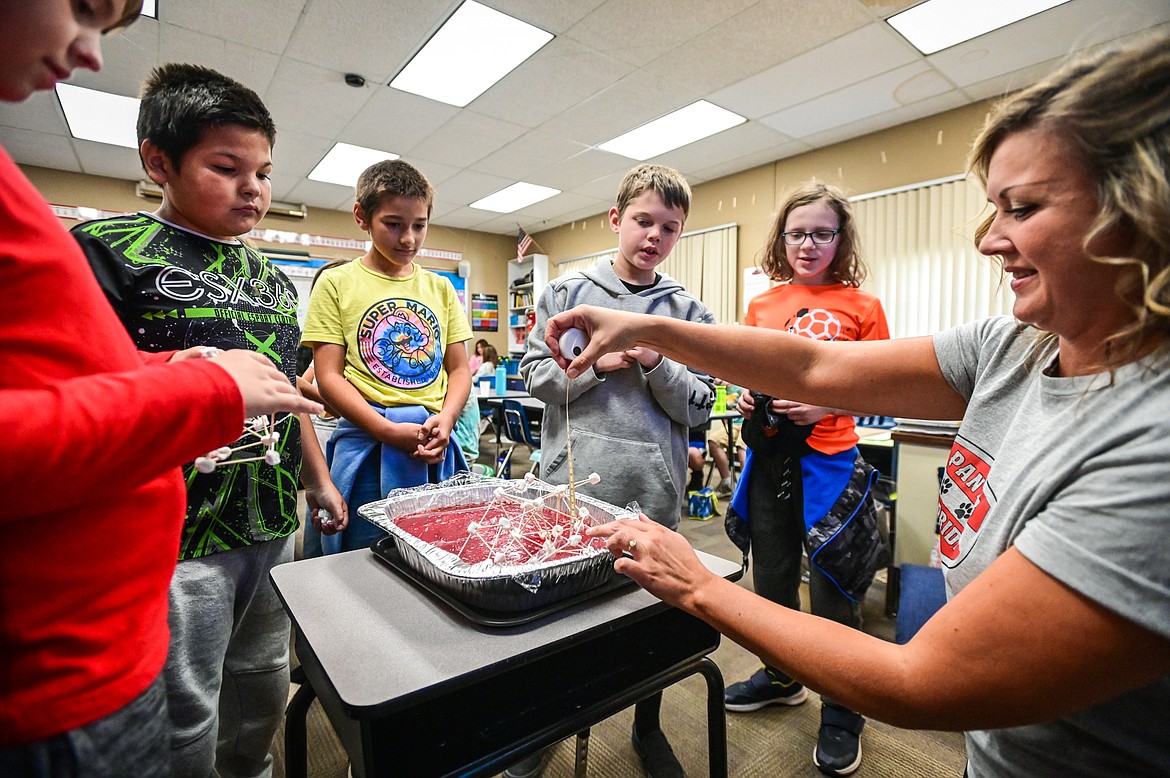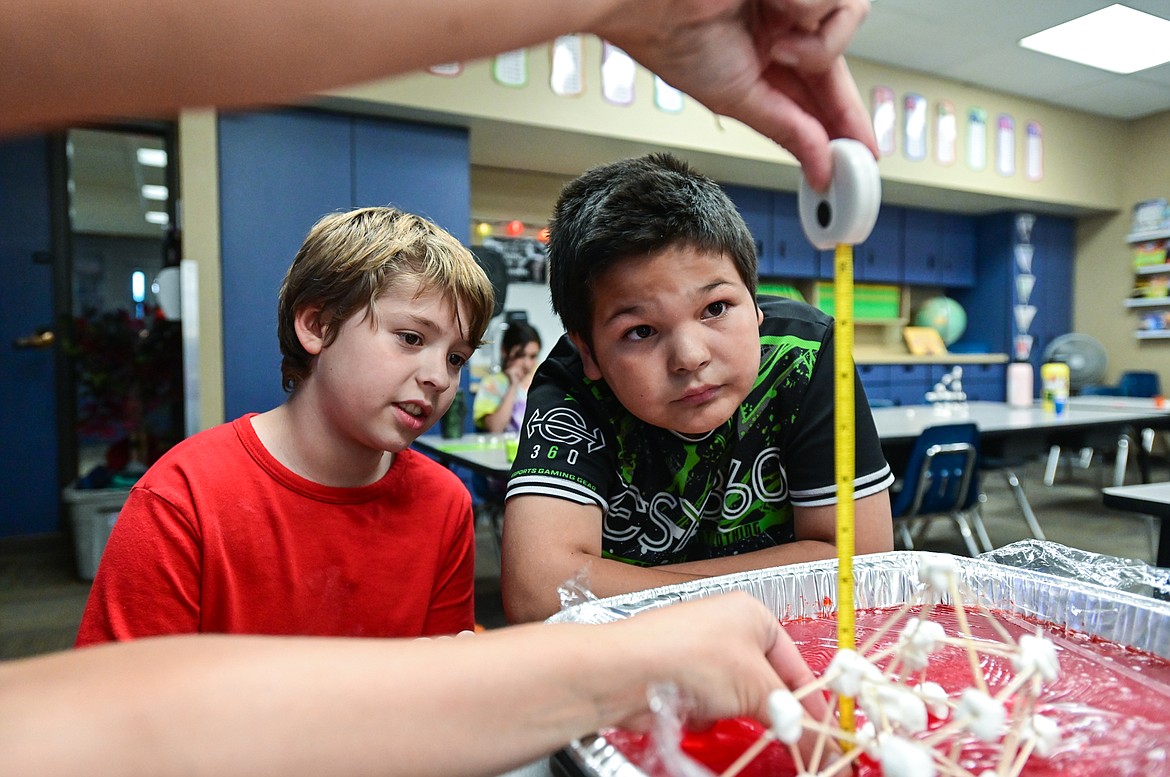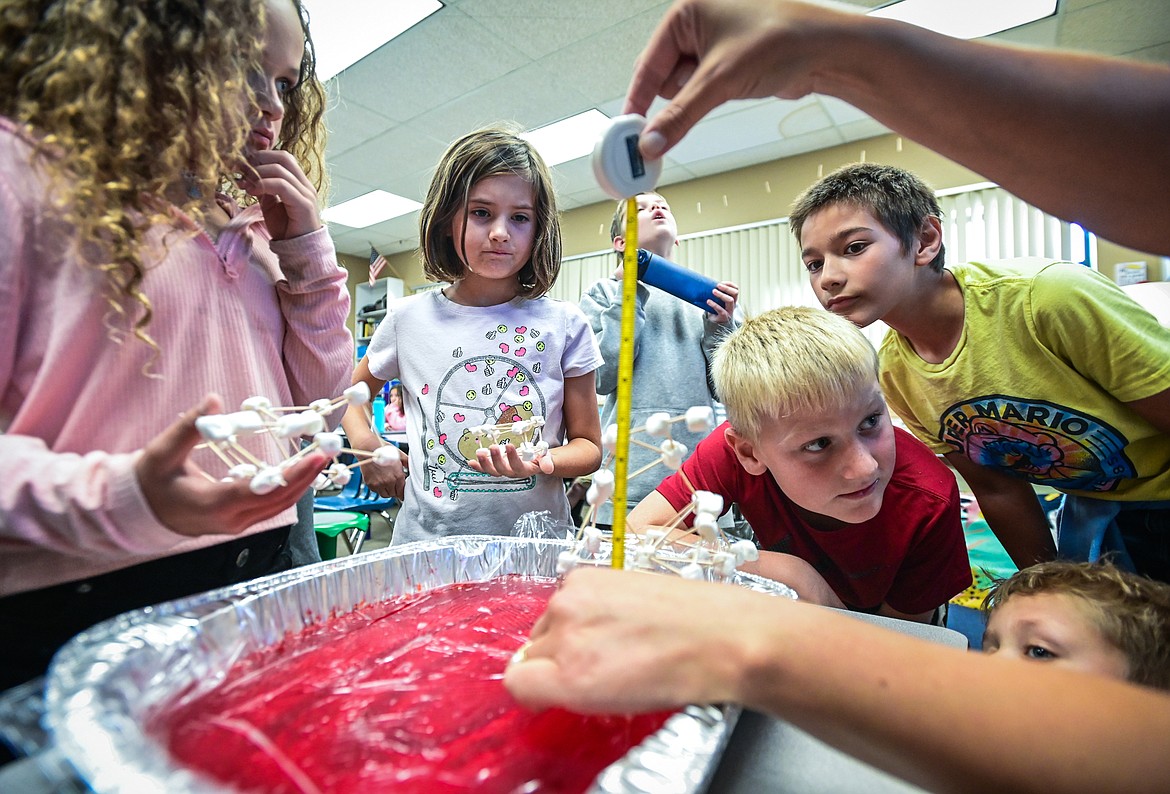Peterson School experiments with science curriculum
Science is an extension of a child’s everyday world, Peterson Elementary Principal Tracy Ketchum told the Kalispell Public Schools board of trustees in September.
“Children have a natural curiosity,” she said during a presentation on how the staff at Peterson spent about eight weeks developing a science curriculum and establishing what life science, physical science and earth/space science content is taught at each grade level to ensure students engage in deeper learning.
Despite the district’s continued emphasis on STEM (science, technology, engineering and math), “We’ve allowed the arts and sciences to take a backseat” at the elementary level as opposed to middle school and high school, Ketchum said. “And in doing so, [we] have squelched that innate desire to question and explore their world.”
“All of the money is being poured into middle and high school STEM initiatives,” she later noted.
At the end of the 2021-22 school year, Peterson educators met in professional learning communities on a weekly basis, to prioritize the list of state standards and create a usable curriculum.
But why now?
“It isn’t that the desire was lacking. It was time. It’s just time,” Ketchum said.
Without textbooks or a pre-packaged curriculum, it’s been up to teachers to design lessons, and activities and source materials, which often results in spending money out of pocket if, for example, an experiment is involved.
“We know what to teach based on the standards, but we’re not looking out of a book. So what we focused on at Peterson was the instruction side of it. How are we going to teach the standards?” said Shay LaCasse, instructional coach at Peterson.
Ketchum said the decision to not purchase a textbook or pre-packaged curriculum is because it’s very expensive. Textbooks also grow outdated. Additionally, LaCasse said the tendency when using textbooks is to teach each discipline as a stand-alone subject, at a time when cross-curricular instruction is encouraged. Cross-curricular instruction means teaching multiple subjects simultaneously.
LaCasse said the other benefit of developing a curriculum in-house allows educators to bring their individual teaching styles and strengths to the classroom or grade level.
“I think it’s bringing the craft back into teaching a little bit,” LaCasse said.
TO START the process, teachers were given a survey to assess what they were teaching and when; what resources they had; and what their science needs were, LaCasse said.
The results showed that there was a tendency for science content to be taught at a surface level, that teachers felt there was a lack of resources and they needed more time to plan meaningful science units, among other items.
“We found a lot of people were just doing the Mentos and Coke experiment. Things that they could just go quickly buy and maybe have a little experiment and talk about it but not get into the depth of what was the actual chemical reaction,” LaCasse said, offering an example.
“I think some of the exposure on that is good — getting the kids excited for science — but I don’t think we were going deep enough into that content,” she said.
As far as content: “We were kind of all over the map in what we were teaching,” LaCasse said.
After the school prioritized the state science standards, staff broke down the complex language in a way that could more easily be understood by teachers, students and parents alike as to what students needed to learn.
“The recommendation is to narrow it down to eight standards that you could teach in a year for that content,” LaCasse said. “I’d say there are close to at least 15 per grade level if you broke down life science, physical science and all of that. We can’t teach them all.”
Staff identified essential content that should be taught in each grade level. From there, they built a usable curriculum. The school created charts and templates to help define what subjects and units each grade level will teach in addition to providing information such as what essential questions students should be able to answer, the learning progression (standards taught in the grade below and above), learning targets, to breaking up a unit into eight days of lessons, objectives, vocabulary and materials.
“Teachers coming into our school can see, oh, these are my big ideas overall for the year that I need to teach,” LaCasse said.
It will also be helpful if a teacher changes what grade they teach at Peterson, Ketchum added.
The last four weeks of the process were spent with each grade level choosing a unit to teach this year that they either hadn’t taught before, or one they have taught, but wanted to take it farther or make improvements, LaCasse said.
One template provides room for teachers to list up to three subjects and the standards addressed, which is where cross-curricular instruction comes in.
“Eventually, we’re hoping they [teachers] integrate some of those reading and math standards and even writing with the science they’re teaching,” Ketchum said.
CROSS-CURRICULAR instruction was in full force in fourth-grade teacher Karissa Prewitt’s classroom on Sept. 27. She combined science content with reading, note taking, expository writing and speaking to dive into teaching her class how the Earth’s surface changes through weathering, erosion, deposition and natural disasters.
For the day's lesson, students read an expository story in their reading textbook from McGraw Hill’s “Wonders” literacy curriculum, which LaCasse said is filled with different genres that apply to teaching content in different subjects such as social studies. LaCasse and Ketchum said it takes time for teachers to go through materials, create and align lesson plans and assessments to standards.
“There’s a lot on teachers’ plates, which we know,” LaCasse said, which is why the school wanted to help standardize the process.
On an overhead, Prewitt displayed a two-column format to organize notes based on what they read. All Peterson students use the format for expository writing. At the top of the paper, students copy the overall topic. In one column, they list two key ideas from the story. In the other column, they list supporting details. From there, Prewitt and students craft an expository essay, Then, some students are picked to read their essay out loud to the class. While there is not enough time for everyone to read, Prewitt asked students to read aloud to the classmate sitting across from them.
This way, all students get to practice speaking. It is also a tactic for students to share ideas with each other without taking up a lot of time and a way for students to feel their voices are heard, Ketchum said.
“We’ve managed to connect science, reading and writing and even speech all into the same hour, so we’re making the most of the short amount of time we have,” Prewitt said.
Learning content through the lens of different subjects helps children make connections in how information is useful in other areas.
This is not the end of the lesson, and the fun, however. At the end of the week, the unit concludes with a hands-on experiment learning about earthquakes with gelatin and building structures using marshmallows and toothpicks.
The experiment, rather than serving as the center of teaching science content at the elementary level, instead caps off a week of deeper learning.
By the end of this school year, all teachers will have experience delivering a science unit and the school will evaluate how it went and refine it, Ketchum said.
“This is standards-based learning at its best because we don’t have a book to plow through. We had to start at the standards level and build from there. We want to start the process again,” Ketchum said, with math or possibly social studies.
Assistant Superintendent Matt Jensen noted that the district's decision to continue dismissing students early on Wednesdays, a practice that started during the pandemic to give students and teachers to catch up on work, now serves as an opportunity to take these “really deep dives” into curriculum and instruction.
“And they need time to do that,” Jensen said. “Without that time you fall into this trap of just teaching to a curriculum that’s a canned curriculum, so I applaud Peterson — the whole staff — for just investing that effort,” Jensen said.
“This is the really good work that happens during that early-release time,” he said.
Reporter Hilary Matheson may be reached at 758-4431 or hmatheson@dailyinterlake.com.





